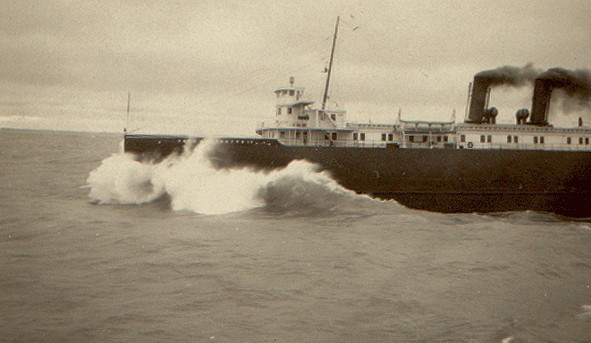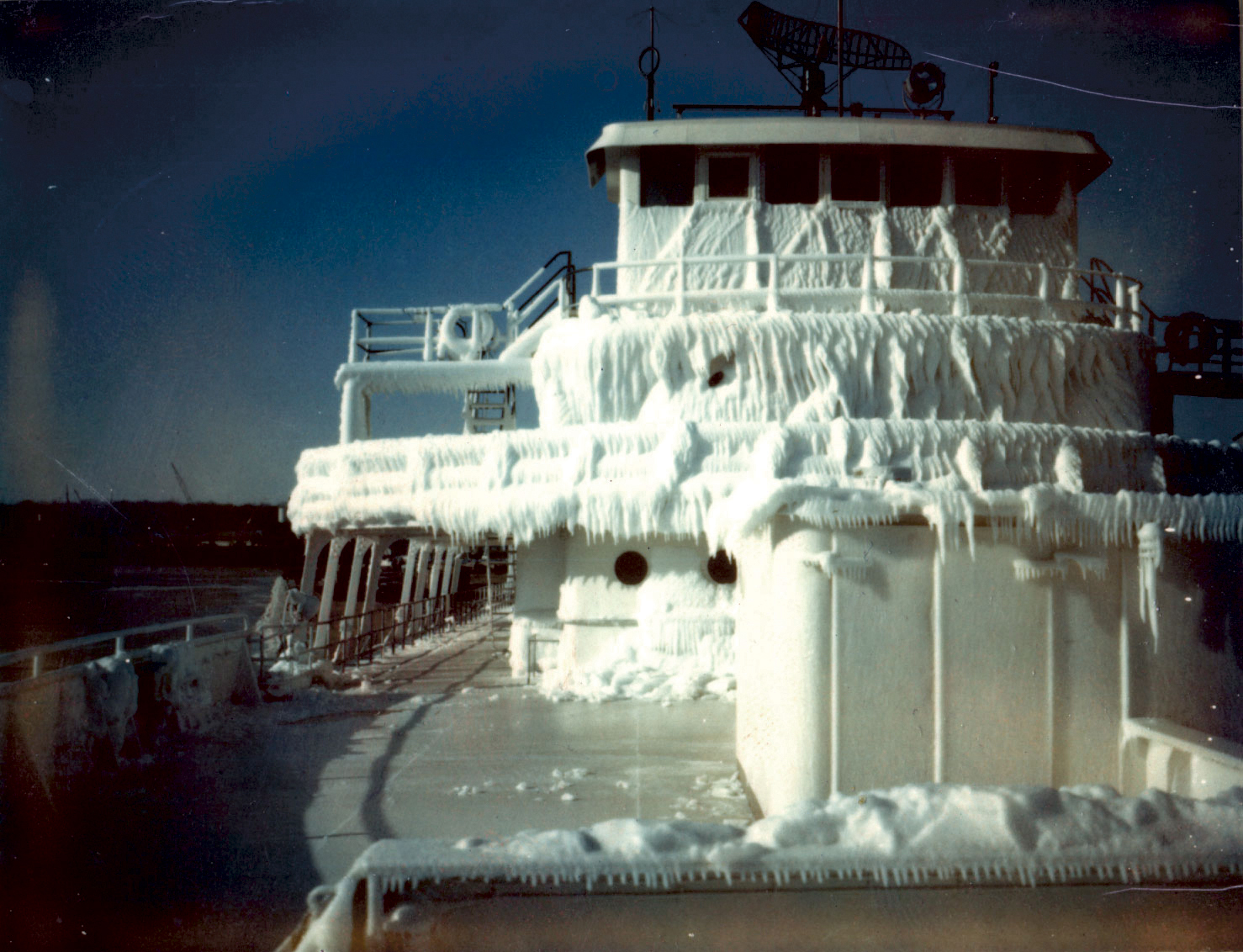First-person account of a fall storm from the deck
The marine forecast was foreboding, so the captain of the Ann Arbor car ferry Viking chose to stay at the dock in Elberta after loading 22 railroad boxcars aboard to “wait for the weather to show its hand.” It was early November 1978, a time for caution amongst Great Lakes mariners. The wind was beginning to rise, but I was now off watch, so I crawled into my warm bunk and drifted to sleep listening to the gentle moan of the wind in the rigging.
My slumber was later broken with a loud knock on the door. “All hands on deck, we are leaving the dock!” shouted the watchstander. Moments later, the ship’s mighty horn sounded one long blast, followed by a short blast and another long one, to summon any of the crewmembers who had not heeded the captain’s request to stay aboard.
I hurriedly dressed and stepped outside. The wind was howling and nearly swept me down the deck and ladder. I could hear the waves striking the south breakwall and the hiss of spray.
The scene below, on deck at the loading apron, was tense. One of the steel cables holding the ship to the dock had snapped, and the others were straining as the 350-foot ship lurched at its moorings. The wind had veered enough westward to send storm-wave energy into Lake Betsie, long known to be the harbor’s failing. There was no way to keep the ship at the dock. We would be forced to cross Lake Michigan in a full-on November storm.
Every decision, every movement in such context can be a fatal one. Releasing the ship from its failing moorings could cost a mariner his hand or leg if struck by a cable. If not orchestrated perfectly, the ship could careen into the breakwall or run aground and be beaten to pieces. Even the slightest failing of communication, timing, or mechanical ability of the ship could portend disaster.
By means of a good ship and a capable master and crew, we cleared the menaces of the harbor for open water. There, the real magnitude of the storm presented itself.

But one need not be a mariner to understand the fury of fall weather on and around the Great Lakes nor its consequences for those both ashore and at sea. My friend Charles Anderson, 87 years old at the time of his passing, was a long-time Frankfort commercial fisherman who often referenced the “Equinoxial Blow.” He explained it as “the definitive storm of the season, the battle between the north and south winds,” by which the north wind would henceforth prevail. He had lived through many of the great fall storms of the 20th century: the “Big Blow” of 1913, 19 ships lost, 250 dead; “Black Friday” of 1916, four ships, lost 42 dead; the “1929 Storm,” three ships lost and 75 dead; “Armistice Day Storm” of 1940, five ships lost, 66 dead; and the “November Gale” of 1975 that claimed the Edmund Fitzgerald. Charlie knew a thing or two about fall weather on the Great Lakes.
Like Charlie, those ashore bear witness to the savage waves that strip away and steepen the beaches. They watch the sugar sand from Frankfort’s summer beach blow down Main Street as people sit parked at the turnaround being rocked and buffeted in their cars. The sounds of clacking defoliated branches and the groaning of old trees are carried on the howling winds from the woods. Trash cans and a curious array of anything not tied down blow and roll across yards and streets.
The same was true more than 100 years ago. In 1892, there was a political convention in Traverse City that was attended by many Benzie County residents. The din of a fall storm above the roof of the City Opera House was so loud that it drowned out the brass band who were playing for the convention. As the band played on, the steamer W.H. Gilcher—the largest and most modern steel ship on the lakes at the time—vanished in the storm near the Manitou islands. As convention goers rode the train back to Benzie County the next day, “there was scarcely a fencerow or barn still standing,” according to an old newspaper article. A ballad written and sung about the Gilcher tragedy at the time went in part:
Never once did dream:
Brave hearts sailed under canvas
And brave hearts sailed under steam.
Lost on Lake Michigan
They failed to reach the shore;
The gallant ships and crews
Will sail the Lakes no more!
So in 1978, all of this history was racing through my mind as I realized that we were heading into the teeth of a November storm. A railroad car ferry is a sturdy vessel; however, a cargo on wheels and a nearly open stern makes it vulnerable in heavy seas. (To appreciate that, one only need look at the ferry Ann Arbor #4’s epic struggle in a storm, as portrayed by the mural in the Frankfort Post Office.)
The Viking’s speed was 90 revolutions of the propeller per minute, just enough to allow the wheelsman to keep the bow into the storm and the propellers in the water. Each immense wave rose like a mountain before us, and the searchlight was used to help navigate through them. The beam penetrated deep into water beneath the white frothing tops, eerily illuminating each wall of water a deep iridescent blue-green.
Occasionally, tons of water hurling through the air from a plunging breaker would strike the bow. A loud thud with a resounding jolt and reverberation would run from stem to stern and momentarily halt the Viking in its path. The train cars below would groan, straining the chains, clamps, and jacks that were attempting to hold them fast. Every so often, the rifle-like report of a breaking chain or the clank of a falling jack could be heard below on the car deck, further adding to tensions. Should a string of cars become loose and roll out the back of the ship, capsize would be imminent, and there would be no surviving in a lifeboat or raft in such a cold and angry sea. When the car ferry Milwaukee sank in a 1929 storm, not a single person survived.
The hours passed slowly as the Viking endeavored to make its way to the shelter of the Wisconsin shore, the crew working throughout the night to keep the cars secure. At daybreak, the shelter of the windward shore was at hand and the Viking made port. After discharging the cargo and reloading, we put back out onto the lake. The wind, now gusting to nearly 50 miles per hour, had veered to the northwest, and the temperature plummeted, so the Viking traveled up and down the protective shore of the Door County peninsula. By late afternoon, a crossing was attempted. The seas were tremendous. As the Sleeping Bear Dunes and the Frankfort bluffs came into view, what had been golden was now a frozen winter-white landscape. “The Witch of November came stealing” as Gordon Lightfoot put it in his Edmund Fitzgerald ballad.
The captain had reservations about attempting to make the harbor. The marine superintendent ashore, determined to keep the freight moving, assured the Viking on the marine radio that “winds had dropped to occasional gusts of 30 miles per hour.” But when the mate and I looked at the ship’s wind speed indicator, it showed a steady 45 miles per hour with gusts to 57.
The ship’s best wheelsman was called to the wheelhouse, and an attempt was made to gain the harbor. We could see the spray from the waves going clear over the lighthouse. A tense stillness fell upon the bridge as the captain, mate, and wheelsman worked in concert to guide the ship. The Viking yawed into the deep trough of the waves. As the harbor grew close, we could see throngs of people parked at the Frankfort turnaround and atop Elberta bluff gazing out at our struggle, hoping, like us, that a scene of disaster was not about to unfold. Finally, the moment was at hand, and the Viking, not unlike a surfer riding a chosen wave, slipped at nearly full speed between the breakwalls. Once abreast of the Coast Guard station, the ship trembled as the propellers worked hard astern to check our way and swing into the dock.
In just 24 hours, November had transformed my harbor town from fall to winter. Looking back out to the torrent of wind and water, it hardly seemed possible that we could have survived such freshwater fury, but we had.
This year, not unlike those of the past, all of us who call the dramatic coast of Northwest Michigan home will again experience the exhilarating drama of the seasons changing and the “Witch of November.”





I enjoyed reading this very interesting look at what it was like to be part of the crew on the Viking. Who was the captain at the time?
Brrrrr – great story for this snowy November morning!
Great story, Jed! Especially reading it from Florida! Miss you all, but not the weather. Susan
Very nice read. Remeber being on the Viking when Capt. Bruce tore the dock out in a storm trying to dock.
Nearly forgot that storm and story. Sure enjoyed reading the accounts of those hours. Thanks, what a reminder. Miss the boats and railroad. Born in Frankfort and spent my life in and around Benzie County. Beautiful place.
I worked for Luedtke Engineering, Frankfort on a job in Milwaukee, Wisconsin. I was on the Viking that night. I was the only passenger. I was very sea sick. The Porter gave me saltine crackers and offered me a stateroom, but i decided to stay in the lounge. It was scary. The boat went up and then rolled side to side, then up again. I remember talking to one of the deck hands who told me that he was watching the cars out of concern that theyd break a chain. I heard what sounded like huge bullets and I was told months later, after it was in the shipyard that the boat had lost rivets. It took us 10 hours to cross the lake. The Captain told me he went North and then back down the coast of Wisconsin. It was a very scary night. I thought I was going to die.
Nancy Wilson, Arcadia, Michigan